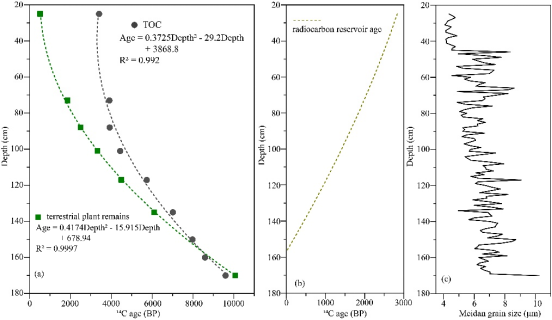the assessment and correction of the radiocarbon reservoir effect is one of the important aspects of the carbon 14 dating of total organic carbon in lake sediments, and the correction is mostly done by deducting the carbon pool age from the sediment surface. it is difficult to study the change of the carbon pool effect over time, which may also lead to bias in the reconstructed dating framework. therefore, assessing the ephemeral changes of the carbon pool effect of whole-organic dating of lake sediments and its influencing factors can help to construct a more accurate dating framework of lake sediments and thus reconstruct the past natural environmental change processes.
in this study, the carbon 14 dating of total organic carbon and plant residues in the sediments of kanas lake located in the southern foothills of the altai mountains was carried out to determine the process of carbon pool effect since the holocene in kanas lake, and the results showed that the carbon pool age increased continuously from 0 to about 2800 years between 9700 and 530 years ago (fig. 1).the study showed that the effect of hard water effect and aquatic plants on the carbon pool effect was excluded according to the fact that there was no carbonate in the region and that the lake had low productivity, large central water depth and almost no aquatic plant growth. the carbon and nitrogen isotope analysis of the sediment showed that the organic matter featured terrestrial plant sources, and the time of appearance of the carbon pool effect in the lake was highly consistent with the development of peat in the surrounding mountains, inferring that the total organic carbon in the sediment was mainly from the soil and peat in the mountains around the lake.

fig. 1 chronological change of sediment carbon pool in kanas lake
based on the above understanding, combined with the background of regional climate and environmental changes, this study tentatively constructed a model for the long-term increase of the carbon pool effect in lake sediments during the holocene.it is proposed that the continuous regional wetting climate since the holocene promoted the development of mountain soils and peat, while the wetter climate may have led to the increasing degree of erosion of mountain soils, and the incorporation of more and older organic matter led to the continuous increase in the carbon pool age of kanas lake sediments (fig. 2).

fig. 2 schematic diagram of the carbon pool effect in kanas lake during the holocene
the research results were recently published online in radiocarbon, an international journal specializing in the field of carbon fourteenth dating. the title is "soil erosion caused the increasing holocene radiocarbon reservoir effect of lake kanas in the altai mountains". experimentalist cao huihui is the first author of the paper, professor huang xiaozhong is the corresponding author, and co-authors include dr. xiang lixiong from the college of earth and environmental sciences. this study was co-funded by the national key r&d project and the national natural science foundation of china (project no. 2017yfa0603403, 41571182). the paper, partly dated by the carbon 14 dating laboratory of lanzhou university, is also the second recent article in the radiocarbon journal, showing the progress of the laboratory in dating accuracy and lake chronology research.
link to article: https://www.doi.org/10.1017/rdc.2022.93